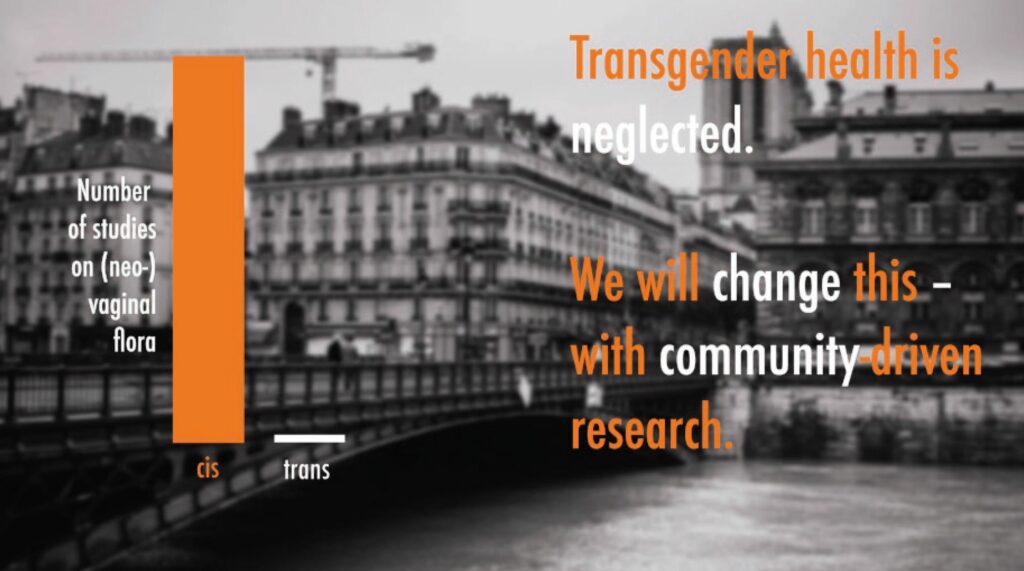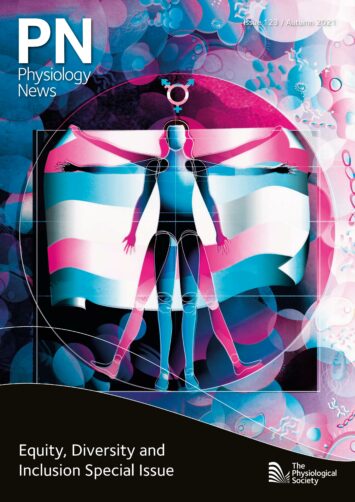
Physiology News Magazine
Nothing about us, without us
Are we asking the right questions in transgender research?
Features
Nothing about us, without us
Are we asking the right questions in transgender research?
Features
https://doi.org/10.36866/pn.123.24
Clara Lehenaff, Université de Paris, INSERM U1284, Center for Research and Interdisciplinarity, Paris, France
Dr Bastian Greshake Tzovaras, Université de Paris, INSERM U1284, Center for Research and Interdisciplinarity, Paris, France
Dr Mad Price Ball, Open Humans Foundation, US
The absence of research in transgender health has real consequences – consequences that some of us have experienced firsthand. One of us (Clara), a trans woman, recently had to deal with vaginal flora dysbiosis; a condition in which the homeostasis of the microbial flora is disrupted. She observed distinct changes in odour and discharge, which seemed to fall within discrete types and could change dramatically over a period of weeks. This observation sparked her curiosity. But when she started to explore the scientific literature, no knowledge seemed to exist on the topic. To address the dysbiosis, she obtained probiotics at the local pharmacy, not knowing whether those would actually work for her own physiology. While these often did seem to help, there was a fundamental lack of information – no one seemed to know what the trans woman’s vaginal flora consists of.
Understanding the (neo)vaginal microbiome
The vaginal microbiome of cis women has been extensively characterised thanks to metagenomic sequencing. This technology allows the identification of individual bacterial species based on conserved 16S ribosomal RNA genes and thus enables the mapping of bacterial communities. Based on this, we know that cis women’s vaginal microbiome mainly falls within five distinct community state types that are characterised by dominant bacterial taxa (Ravel et al., 2011). Furthermore, it is now clear that the vaginal microbiome is linked to a variety of health issues and diseases, that not only include dysbiosis but also gynaecological cancers (Champer et al., 2018) and neoplasia (Mitra et al., 2015).
This is in stark contrast to the scientific knowledge on the neovaginal microbiome. Many trans women undergo vaginoplasty surgery; the resulting organ – often called a neovagina – becomes populated with a microbial community. So far, how the neovaginal microbiome is implicated in health conditions is not only unknown, but even its basic composition is largely unclear, with only three studies having tried to address the question of how diverse the neovaginal microbiome is (Weyers et al., 2009; Rizzo et al., 2018; Birse et al., 2020). While each study represents an important effort, all studies to date have significant limitations, in particular with respect to the variety of surgical techniques used to create a neovagina – e.g. using penile, scrotal, and/or intestinal tissues – with most studies only investigating a single surgery type. Furthermore, small sample sizes, a lack of time between surgery and microbiome sample collection and a focus on culturable bacteria make it unlikely that the true diversity of the neovaginal microbiome has been accurately captured.

The Transbiome project
To address this knowledge gap, we decided to launch Transbiome (www.transbiome.org) – our own metagenomic exploratory research project. We wanted to start answering the question: what does the vaginal flora of trans women look like? And is there a correlation between the microbiome and factors such as surgery technique and postoperative care? In addition, based on the research on cis women’s vaginal microbiome we suspect that self-care and other factors may influence the microbiota, including: douching, infections, medication and probiotics, and sexual behaviour. In the midst of all these potential influences, very little is known – even about whether any “typical” microbial state exists! Transbiome aims to improve this situation by profiling the bacterial and fungal species of up to 50 samples contributed by trans women. Beyond increasing the sample size by a factor of 5-10x compared with other recent metagenomic/metaproteomic studies, we additionally expect a larger diversity in our cohort of surgery types, and sample collection time post-surgery among other factors.
From the start, we envisioned Transbiome to be done by the community, for the community – allowing trans women to help and contribute to building the science. After initial discussions on the protocol design, we shared the effort on social media and launched a successful crowdfunding campaign; thanks to over 200 contributors, we have funding to cover sample collection and analysis costs. With support of communities in France, Germany, and Spain, our outreach also helped reach trans women across Europe that volunteered to contribute samples. Study participants were sent a kit by mail, asked to sample their own flora themselves, send back the samples, and complete an online questionnaire. The analysis of the first 35 samples is currently underway, and we are exploring potential future studies, e.g. studying longitudinal changes and stability of the microbiome over time.
Gaps in trans research
Transbiome seeks to understand the neovaginal microbiome, but there are other trans-related topics that may be underexplored (Ortiz-Martínez and Ríos-González 2017). Another firsthand experience we can share relates to transgender hormone therapy, a routine aspect of medical transition. Another author (Mad), after beginning testosterone therapy, was surprised by a physiological change not addressed by their informed consent process: an effect on crying. Testosterone therapy resulted in an immediate and dramatic reduction in their capacity to cry. Belatedly they discovered it was a common experience reported by others in online forums, and the effect seems to have attenuated over time. While an impact on lacrimal function from increased testosterone (or indirect effects on prolactin) may be consistent with existing literature (Mathers et al., 1998), it was seemingly absent in transgender research and clinical information.
Transgender communities raise a variety of questions the authors are familiar with, for example: Do trans women have a hormonal cycle? Or could cycling the treatment be a good idea? What are the symptoms associated with vaginal and uterine atrophy in transgender men, and how can they be managed? How are trans womens’ penises and testicles affected by oestrogen and testosterone blockers? And what about other organs? How does hormone therapy affect future fertility? Should lactation be induced in the trans parent when a child is born? And there are many more. How well does the current state of research cover these?
Historically, funding has been scarce for LGBT research (Coulter et al., 2014), and transgender issues remain a subset within these. Furthermore, an “LGBT” grouping may be problematic, as it combines transgender communities with sexual orientation minorities. Research related to sexual orientation understandably focuses on fields influenced by sexual and social behaviour. However, unlike sexual orientation, the concerns of many transgender individuals relate to physiological topics involved in gender-affirming medical transition (see Table 1).
This bias likely affects the focus of research, potentially reducing focus on physiological questions relevant to the transgender community. When we examined a random
sample of 280 trans-related publications, the majority of these were about medical policies, sociology and society, sexually transmitted diseases, and mental health. This is a stark contrast to physiology-related interests we’ve seen in transgender communities: When we asked the question of which research would be useful to trans individuals in a Facebook group on trans issues, the answers were mostly related to transgender hormone therapy. In our sample, only roughly 5% of literature seemed related to hormone therapy.

Mapping the state of trans research
A comprehensive understanding requires better knowledge of the current state of transgender research – and we’re interested in seeing this improve. While a number of systematic reviews on trans topics exist, they exhibit the same skew in topics as individual research with most of them addressing medical policies, mental health and sexually transmitted infections.
A potential topic for our future work might be a project that better addresses this. We envision a participatory project, inviting contributions from trans individuals and allies, which could be used to better map the state of trans research. For example, a web-based tool could automatically track all trans-related publications, invite contributors to classify and tag these, and enable users to explore trans-related literature according to topic. Given the low number of publications, we could have a first mapping completed in less than a year.
Our sense is that research into the physiological aspects of transition is scarce. Mapping current research would give a better insight into
this. It would also provide both transgender individuals and clinical practitioners with a better way to navigate what is “known”.
Closing the gaps – with the community
Topics of research are influenced by the perspectives and interests of funders and researchers. When these entities are overwhelmingly cis-gendered, what they see as relevant, interesting, and important may unintentionally stray far from the interests and needs of the transgender community (Galupo, 2017). In that sense, transgender research reproduces the biases we see in media and art fields, where trans people are often written, drawn, and portrayed by cis writers, painters, and actors. These can lead to a representation that is unrelatable, unrecognisable, and even insulting to the trans community.
How can we close this gap? There are a number of approaches that can help improve the situation. First, research needs a better overview of the concerns and needs of the trans community. For example, one could survey the trans population to identify which research questions they view as priorities. A similar approach has been taken in the past by a UK charity, Autistica, to generate a list of research priorities voiced by autistic people (“Your Questions: Shaping Future Autism Research” 2016). Furthermore, as the time and resources of individuals are often limited, inviting trans associations to be involved and influence research agendas could be greatly beneficial as it is their goal to represent and support transgender communities.
Second, beyond the research agenda setting we think it would be highly beneficial to make deliberate efforts to also include the community in later stages of research – e.g. in the design and testing of research protocols. Trans people have unique experiences that mean they can bring insights, viewpoints, and ideas that cis people are unlikely to have (Katz-Wise et al,. 2019). As a result, their inclusion could greatly improve the quality of research.
This is not to say, however, that only trans individuals can research trans individuals. We should, on the contrary, put more effort into researching trans issues in the wider scientific and medical community. But it seems that, in general, forgetting to include the minority that is researched in the process of researching greatly impairs the scope and impact of the research.
References
Birse KD et al. (2020). The neovaginal microbiome of transgender women post-gender reassignment surgery. Microbiome 8(1), 61. https://doi.org/10.1186/s40168-020-00804-1
Champer M et al. (2018). The role of the vaginal microbiome in gynaecological cancer. BJOG: An International Journal of Obstetrics and Gynaecology 125(3), 309–315. https://doi.org/10.1111/1471-
0528.14631
Coulter RWS et al. (2014). Research funded by the National Institutes of Health on the health of lesbian, gay, bisexual, and transgender populations. American Journal of Public Health 104(2), e105–112. https://doi.org/10.2105/AJPH.2013.301501
Galupo MP (2017). Researching while cisgender: Identity considerations for transgender research. International Journal of Transgenderism 18(3), 241–242. https://doi.org/10.1080/15532739.20
17.1342503
Katz-Wise SL et al. (2019). Lessons from a community-based participatory research study with transgender and gender nonconforming youth and their families. Action Research 17(2), 186–207.
https://doi.org/10.1177/1476750318818875
Mathers WD et al. (1998). Menopause and tear function: The influence of prolactin and sex hormones on human tear production. Cornea 17(4), 353. https://doi.org/10.1097/00003226-199807000-00002
Mitra ADA et al. (2015). Cervical intraepithelial neoplasia disease progression is associated with increased vaginal microbiome diversity. Scientific Reports 5 (November), 16865. https://doi.org/10.1038/srep16865
Ortiz-Martínez Y and Ríos-González CM (2017). Need for more research on and health interventions for transgender people. Sexual Health 14(2), 196. https://doi.org/10.1071/SH16148
Ravel J et al. (2011). Vaginal microbiome of reproductive-age women. Proceedings of the National Academy of Sciences of the United States of America 108 Suppl 1 (March), 4680–4687. https://doi.org/10.1073/pnas.1002611107
Rizzo M et al. (2018). MP15-10 neovaginal microflora after surgical gender reassignment in HIV, HBV, and HCV seronegative transsexual women. Journal of Urology 199(4S) e192. https://doi.org/10.1016/j.juro.2018.02.523
Weyers S et al. (2009). Microflora of the Penile Skin-Lined Neovagina of Transsexual Women. BMC Microbiology 9(1), 102. https://doi.org/10.1186/1471-2180-9-102
Your Questions: Shaping Future Autism Research. 2016. Autistica. https://www.autistica.org.uk/downloads/files/Autism-Top-10-Your-Priorities-for-Autism-Research.pdf
